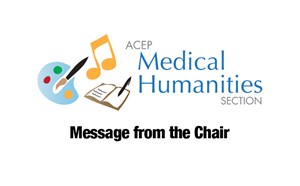
Writing Award Winner, Prose, 2021
“Probabilities,” Joshua Michael, MD
“Good luck and bad luck are all mixed up. You never know what will happen next.”
- Jon Muth, Zen Shorts
Martha’s Vineyard, August 2012
My brother and I were debating the authenticity of the Martha’s Vineyard experience. He saw the place as a charming refuge from the busy New England corridor, while I viewed it as a pandering tourist economy built on the $30 lobster roll. He had invited us to join his wife and daughter on a farm they rent every summer. My older kids were thrilled to join their cousin for a couple of weeks, and we’d promised to make the trip back east for several years. The farm was charming, in a deliberate sort of way. My toddler daughter Aria loved petting the sheep; the older kids played with their cousin on the nearby beach.
At that moment, our family was well.
Any departure from health was background noise. We were statistically as expected: Two healthy parents raising three healthy children in a good home on Bainbridge Island near Seattle. The warp and weft of our life felt secure and unassailable. I knew bad things could happen to our children, but I viewed it as a matter of odds, the likelihood being mostly out of my control. They wore helmets and seatbelts, and generally ate well. Beyond basic safety measures, the well-being of our children is left to probability. My first child Eden was born in 2004, when I was a second year resident. I was of the more hypervigilant sort with that first kid. Her head circumference was in the 99th percentile. Water on the brain, obviously. She fell off a stool and passed out after a crying spell. Yeah, we called 911.
By the time my third child Aria was born in 2011, I cleaved towards the other dad-as-doctor cliche. Fevers would have to last days or the blood would have to be spurting, not oozing. And even then.
On the flight home from Boston, Aria had a little diarrhea and seemed logy. My wife Amy noticed. I didn’t. The next day, she slept. And slept. Amy saw that her stool looked a little orange, and asked me what I thought.
“Eh.”
Beginning to worry, she asked me whether we should bring her in.
“Is she still eating and drinking?” I asked her.
“A little.”
“Okay, let’s just keep an eye on it.”
Diarrhea and loginess happens, and I wasn’t going to be that parent in the ED, especially as an EM doc. Around midnight, Amy told me her diaper was dry and she wasn’t drinking. We live on an island. There were no ferries until morning and if we drove her into Seattle, it would take us 90 minutes.
“Let’s see how she does overnight.”
At about four in the morning, her diaper was still dry.
Amy caught the first ferry of the morning and called me from the ED. Her creatinine was 2.6 and she was being admitted to the ICU. “Damn, she must be really dehydrated,” I thought. Sort of surprising she was being admitted to the unit, though.
I arrived later that morning knowing nothing more. I sat at the bedside with Amy while Aria slept. The pediatric intensivist arrived, an impeccably dressed Italian woman who spoke to us in the language of disquieting concern: formal introductions, sitting down at eye level, long pauses, and asking us how Amy and I are doing at that moment, all while keeping her counsel. I knew it well. The seriousness of her assessment was betrayed only by the gravity of her formality.
She asked us for an unusually detailed history of recent events in our lives. Where had we traveled? Where had we eaten? What restaurants? What days? Anyone else sick? Have you visited any farms? Farms. With that, I knew where she was going. Aria had hemolytic uremic syndrome from a shiga-toxin producing E. Coli infection. She had complete renal failure, a hemoglobin of 5 and maybe a single platelet floating around. She soon developed a pericardial effusion, pancreatitis, liver injury and rectal prolapse.
At that moment, my world became small, dark and quiet.
We had parented according to a sensible coda of helmets, seatbelts, and healthful eating. Yet, nothing obsessive. I could now only recoil in horror at the memory of her on Martha’s Vineyard petting sheep, drinking well water on the farm, and eating farmer’s market veggies. At that moment, the stolid doctor-parent with abiding respect for probability desperately wanted to defenestrate our refrigerator’s vegetable bins full of locally sourced organic produce. I asked Amy’s parents who were looking after our other two children to feed them only canned or boxed food. A man of science indeed. I attempted to straighten myself mentally, diving into papers and again calculating the odds. She was on dialysis with no renal function and multiorgan system involvement, but she still stood a 70% chance of complete recovery.
The intensivist who admitted her was replaced by a folksy military doctor who would spend one week each month in Seattle covering the pediatric ICU. He was maybe less precise during his daily assessments, but his calm and reassuring demeanor short-circuited my literature search-anxiety feedback loop.
She already had a femoral dialysis line but, at this point, she also needed a PICC. Since she was 15 months old, we were given the option of sedation or brutane - we opted for the latter. One nurse wrestled with her wriggly arm, unable to place the line while attempting to maintain a proper sterile field. As Amy and I stepped away from her heart wrenching cries of “aw dun,” a second nurse briskly stepped into the breach and successfully placed the line. All seemed on course.
Back to probabilities.
Still no urine output, though, and her odds of full recovery were drifting downward to around 60 percent, having now been anuric for a week. Two days after the line was placed, she spiked a fever to 106F.
Hours later, an eternity in the parlance of my-kid-is-septic, the infectious disease consultant started ceftriaxone. I wanted them to steer this ship and keep me informed. But, ceftriaxone? That’s it? Do I speak up? I was really hesitant to insert myself in that way into the care of my critically ill daughter.
Still, when the ID doc stopped by on evening rounds, I inquired. She knew that I worked in a hospital that saw mostly adult patients and reassured me that hospital acquired MRSA is very rare in a pediatric ICU, but she read my concern. An hour later, vancomycin was added. That night, Aria’s heart rate increased to 220 beats per minute, her fever raged unabated, and she was nearly unarousable. With no renal function and the fluid around her heart worsening, I quietly estimated that she now had about a 50 percent chance of survival.
I had cognitive dissonance between the prosaic routine of the ICU staff at midnight, which I knew well from my experience as an ED doctor, and the garment rending desperation and grief Amy and I were experiencing. “I know this must be frightening for you, but this is very routine for us,” was a canned line I occasionally used with anxious parents. At that moment though, I was the one who was utterly terrified.
The next day, her blood cultures grew out MRSA.
A culture of the usual sources revealed it was from her PICC line. My reasonable and sensible decision to avoid anesthesia for proper sterile line placement may have resulted in sepsis, coupled with the E. Coli infection. I was no longer feeling reasonable and sensible.
We never discovered the source of her HUS. Aria’s nephrologist was a veteran of the infamous 1993 outbreak of HUS in Seattle that was traced to Jack-in-the-Box beef patties. I knew that statistically, the locus was Martha’s Vineyard; a 90 percent chance, since we had been there most of the two weeks prior.
We managed to put some effort into helping with source identification. First, we left a message with the health district on Martha's Vineyard, but never heard back. As in Spielberg’s Jaws, filmed on Martha's Vineyard, maybe they were in no hurry to scare the tourists.
Our local health district, however, despite how unlikely she was infected close to home, performed an extensive source investigation, including visits to local grocery stores as well as an inspection at a nearby farm where we had purchased produce. They kept in touch with us on a daily basis, and informed us of the results of the state’s genetic fingerprinting of her strain and efforts to match it with any other cases reported to the CDC nationwide.
There were none.
Aria did recover, but not unscathed. Her kidneys were scarred, leaving her with chronic kidney disease and hypertension. We felt supremely lucky she survived, but still disappointment creeped in when reflecting how unlucky she was to draw that short straw so early in life.
We had three children, two were healthy. We had to accept the fait accompli that we now had one with chronic medical problems. We trimmed our sails for a new normal. More Spock, less Kirk.
The likelihood of any additional unrelated illnesses during their childhoods was neither greater nor less than it had been prior to her HUS. The likelihood of future events are not predicated on past ones as long as they are statistically independent. We continued to take all reasonable precautions with our children, and even our food safety habits, while obsessive at first, eventually converged back to the moderate vigilance we observed prior to her illness. Amy and I reminded ourselves we hadn’t been reckless and that most children get through childhood without serious medical problems. Other kids get diarrhea, prompting at most a brief discussion with a doctor about hydration. Ours was a fluke, but it was over. Any health issues that arose among our other two children seemed trivial and almost refreshing. A visit for acne? How prosaic. That’s what children are supposed to be seen for.
In 2017, our son Jonas was swimming with the local team. Butterfly was his best stroke, which causes the sternocleidomastoids to hypertrophy, giving some swimmers a bull neck appearance, particularly among boys approaching puberty. Jonas was now eleven. Still, it seemed out of proportion, given that he hadn’t clearly even started puberty.
At the end of a shift as I’m preparing to leave, I will occasionally pause after experiencing a deep and abiding sense that there is something I am missing or forgetting - an unfinished task or a result that needs follow-up. With Jonas, I was having this same familiar sense. Standing in the kitchen while he was looking up at me, this vague sense materialized into the concrete. It wasn’t his neck muscles, it was his thyroid. It was markedly enlarged, more on the right than the left.
He had a goiter. I knew the statistics. In children, about 80 percent were benign, often due to an autoimmune condition. But the tension between what I knew and what I feared was great. I knew that most children who are seen for diarrhea or a lump in their neck go home with nothing more than reassurance. What I felt now was that our children weren’t so fortunate.
His pediatrician sent us to the ER for an expedited workup. On the way, we stopped for a slice of pizza before hopping the ferry. I was quiet and didn’t feel much like eating. Jonas, however, sensed an excitement in the process. Seeing how Aria had received a lot of attention over the years, he thrilled at the thought of being the focus, if even for a short while.
I sat with him during his ultrasound. Like with Aria’s first intensivist, I read concern. The ultrasonographer was quiet. The exam took a long time and she stepped out several times to discuss the images with the radiologist. I felt it. The statistical crutch I had briefly been leaning on collapsed once again.
He had an aggressive form of papillary thyroid cancer with metastases to the lymph nodes. He underwent a biopsy and further staging. And over the course of the next week alone, the mass in his neck grew. His CT showed evidence his cancer may have already metastasized to his lungs. His surgeon wanted to proceed quickly. The surgery took eleven hours. We were told beforehand there was about a one percent chance that his parathyroid glands would be permanently damaged. After the surgery, the surgeon sat down with us at eye level (damn those eye-level conversations), and told us he was unable to identify Jonas’ parathyroid glands. Odds are though, he informed us, Jonas would do fine. Our probability scale shifted once again. But still, thyroid cancer was usually quite treatable, and the likelihood of permanent damage to the parathyroid glands remained small.
Amy stayed with him the first night and called me in the morning to let me know he had been transferred to the ICU because his calcium level was critically low. His parathyroid function never returned.
We retrimmed our sails. Now on a new path, we expected curative treatment with radioactive iodine.
Back to statistics.
Only one percent of children with thyroid cancer fail to take up radioactive iodine. Jonas was in that one percent. And the subtle findings on his initial CT were no longer equivocal: he had extensive metastatic disease throughout his chest. This cancer was not behaving as expected.
Jonas seemed along for the ride, and emotionally, it did not seem to affect him too much. In fact he appreciated some of the extra attention he was getting and he continued his usual activities--swimming, piano, video games. Surgeries and radioactive quarantine were just what came next. The vulnerability I felt as a parent was the obverse to the invincibility he seemed to feel as a child.
Over the first year after his surgery, he developed several new lymph nodes in his neck. His genetics panel failed to identify the “oncogenic driver.” We did not know what gene or genes were causing his cancer. There was nothing to target. His oncologist at Seattle Children’s, among the most highly regarded experts in pediatric solid tumors in the Pacific Northwest, had been considering throwing various non-selective drugs at it to see what might stick, but without a well-defined strategy in mind. During one of our conversations about this, he paused.
“Maybe you should get a second opinion,” he suggested.
There was no longer a plan. Jonas’ cancer was advancing and there was nothing we knew of that could stop it. Our belief in a path forward turned into a wish. The wish was father to the thought, and we had to believe it.
No longer seeking comfort from the math of probabilities, I turned from the rectitude of Bernoulli to the victimhood of Job. We feared watching my son slowly suffocate, unable to intervene.
We scheduled an appointment with a renowned expert in pediatric endocrine cancers at MD Anderson in Houston. A few weeks before this appointment, his oncologist in ordered a second genetics panel performed using a next generation sequencing method. We were not expecting any change. It was simply the next action to take. Just as there are moments when we first receive bad news that we never forget, there are also moments we recall vividly because of the utter euphoria and the relief they give us. I woke up after sleeping all day during a run of night shifts. Amy had texted me while I was asleep.
“Found mutation. EXPRMNTL drug. Call me!!”
It was a RET fusion, a target for a new drug whose only function was to block this single cancer gene with precision.
In 2019, Jonas went down to Houston for a second surgery. He had an additional 76 lymph nodes removed from his neck and upper mediastinum.
His disease remains relatively stable, save for a single metastatic lesion on the spine. The most sincere and helpful support we have received has generally followed the inverse idiom, “Don’t just do something. Stand there.” Presence, not presents. Occasionally, well-meaning friends would commiserate by trying to identify. “I know how you feel. I remember when our son had pneumonia. They almost admitted him to the hospital.”
“No, you don’t know,” I would think, with an air of entitlement we try diligently to guard against.
It’s impossible to get inside someone else’ head and measure their distress. Fear is both real and subjective. Still, what we would trade for what they have.
We had been wallowing in mixed fortune, seeking reassurance where there was none. I no longer assign probabilities--no longer the anodyne salve I once sought. In the book When Breath Becomes Air, author Paul Kalanithi, a neurosurgeon facing his imminent death from lung cancer writes,
“Getting too deeply into statistics is like trying to quench a thirst with salty water. The angst of facing mortality has no remedy in probability.”
Still, had we lived a hundred years ago, we would have already lost two of our three children. How fortunate we are to live in this time and place. And with perspective on the small stuff.
A few years ago, a neighbor had a daughter with a congenital disease that caused intractable seizures. They eventually moved to Seattle because the frequent helicopter airlifts from the island were too much. We later learned she had died. Now, we could not comprehend their world.
We have a house full of three happy children.



